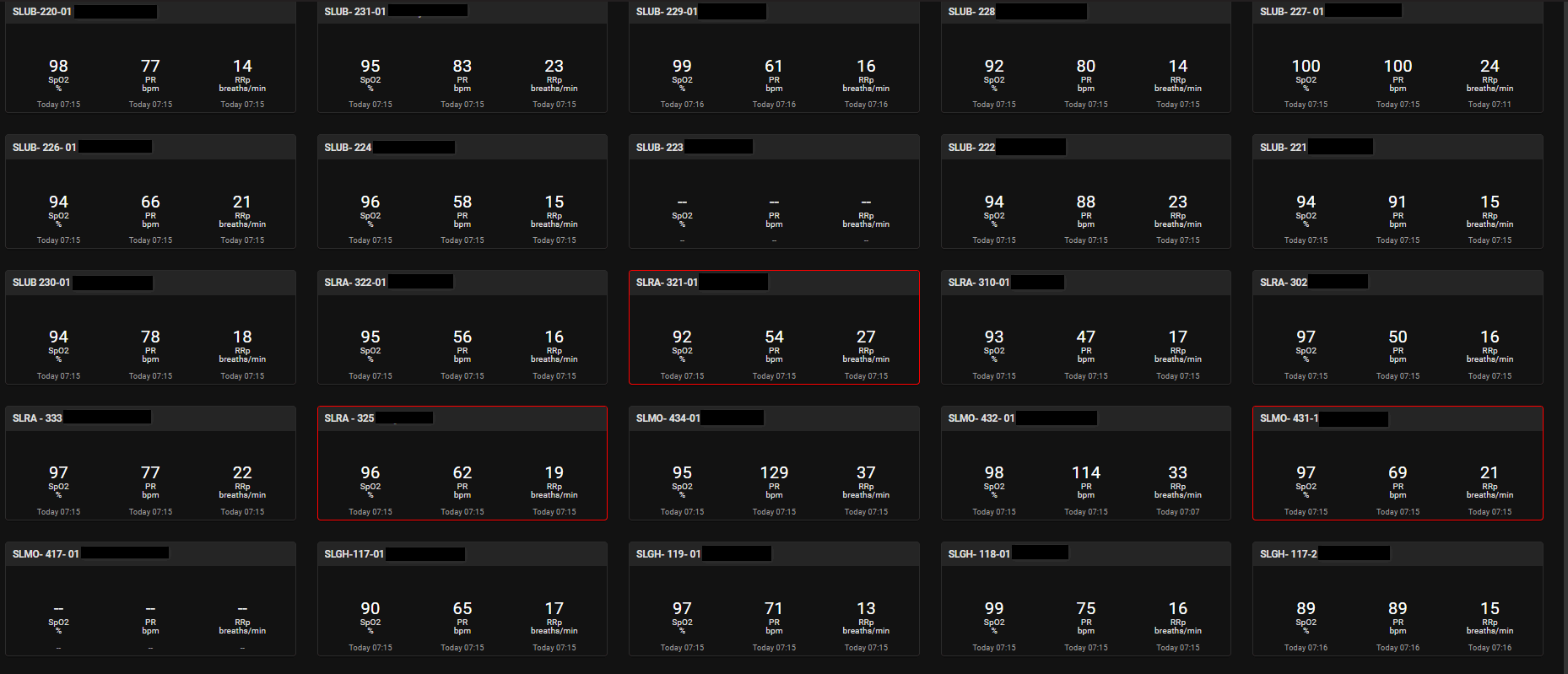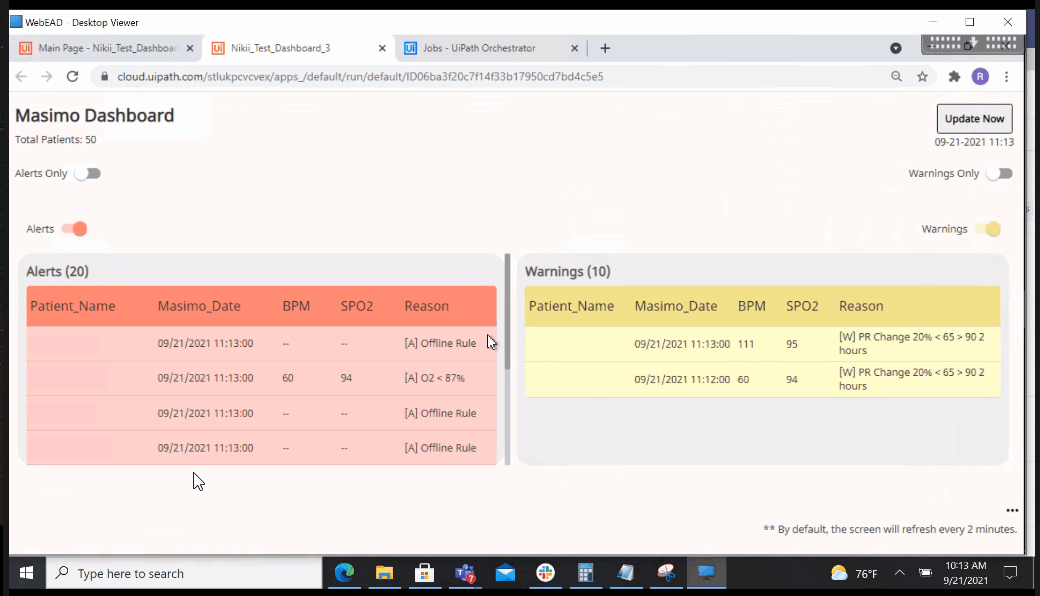Have you ever checked your pulse or oxygen levels with a watch?
It’s common these days, but decades before the Apple Watch or FitBit had these features there was the storied pulse oximeter (pulse ox).
A pulse ox is a small plastic device that sits on the tip of your fingertip, calculating the oxygen saturation of your blood and pulse rate by using light beams.
Created in the 1970’s, it’s still a critical component of care in both hospital and at-home settings. And the “monitors of the monitors” (nursing assistants who check patient pulse ox levels) are vital to healthcare outcomes.
In the Virtual Response Center of a large hospital on the east coast of the United States, nursing assistants monitor pulse oximeters for dozens of patients at any given time. These highly trained staff keep watch for any red notifications (see image below) in their monitoring system, Masimo, constantly having to click onscreen arrows back and forth because only 20 results can be seen at once.
When a pulse ox reading falls below 85, the nursing assistant alerts the doctor on call.

But what if we could predict those pulse ox alerts before there’s an emergency? What if a set of business rules trained from decades of practitioner experience could suggest a proactive “next best action” when a troubling pulse ox pattern is uncovered?
That’s just what we have built for our hospital client.
Read on to explore:
How a 15,000-employee nonprofit hospital network is delivering better care and creating more than $500,000 in value by extending their pulse ox monitoring systems with robotic process automation (RPA)
Advice for how hospitals can deploy time-saving (and potentially life-saving) solutions in weeks using UiPath Apps, the industry’s first automation-powered, low-code app platform
A vision for how healthcare can always have the “next best action” identified through automation
Nursing assistants + digital assistants = excellence
In a day with far too many clicks, countless alerts from all manner of machine, and endless context switching, it’s understandably easy for notification fatigue to arise among nursing assistants.
It can be difficult to stay abreast of just the current state of notifications, let alone model out the future.
That’s where RPA is helping, literally every minute.
Every sixty seconds automations from UiPath:
Look over a patient’s history
Calculate a rate of decline or improvement in pulse ox readings
Leverage a complex set of business rules to determine when people are trending towards a pulse ox rate of 87
Nursing assistants’ digital assistants (say that ten times fast) can help improve patient outcomes by providing trending data throughout the day.
$500,000 in value
Today this hospital doesn’t have the bandwidth to monitor trending data every minute. And even if they did, someone would likely be very bored. Toiling over a complex set of business rules to predict a drop in pulse ox isn’t the high-value, more strategic and personable work that nursing assistants typically enjoy.
By uniting nursing assistants with digital assistants, the hospital expects to see:
Better health outcomes for patients
Lower turnover among nurses
Reduced time of patient stay and readmission rates
$500,000 in value created
Ability to scale the patient monitoring program while leveraging nurses to make clinical decisions as opposed to reviewing patient monitoring systems
35-40% faster than custom development
UiPath Apps was integral to developing this solution for nursing assistants. In a matter of weeks, we built a friendly user experience (UX) layer for nurses. The app appears like any other website or application, but behind the scenes automations are fetching and posting information.


By building the solution in UiPath Apps we were able to finish the project 35-40% faster than if we had used a typical custom development approach. Because solutions made in UiPath Apps are inherently part of the RPA ecosystem, it was a breeze to visualize the output of automations as a single pane of glass. Apps gave us a consolidated single package of user interface (UI) and Robot. Building a custom web app would have required creating connections between it and our automations from scratch. Apps saved us from this work.
And because UiPath Apps is such a low-code, drag-and-drop-friendly tool, we could quickly show our client various takes on a UI. They literally could tell us what they wanted their software interface to look like, a choice few medical practitioners have. Since the streamlined approach was taken with the UI, the development team and clinical subject matter experts (SMEs) could focus on nuances of the complex business rules and detailed test cases instead.
Most of all, this solution showcased how powerful the union of APIs and UI can be. Masimo doesn’t offer any APIs for this use case, but we were still able to source the data needed to predict when patients are trending towards a dangerous pulse ox level.
RPA enables your “next best action”
Extending our clients’ capabilities through RPA has given us a vision for how automation should fit in every hospital’s software stack.
Gaps between desired health outcomes and one’s current software capabilities occur for any number of reasons:
The functionality exists, but licensing for all necessary users is prohibitively expensive
The information exists, scattered on different screens and reports in the application, but surfacing all the data practitioners need in one place, organized the way they need it, is challenging or impossible
The functionality exists, but is only available in batches of reporting that are too slow to action
These gaps exist no matter how modern your suites of software.
RPA fills in the gaps of your enterprise applications. As we talk with industry professionals, a common refrain is how one’s current software stack gets in the way of strategic goals.
The conversation quickly evolves when we introduce automation. We go from complaints about their system limitations to how automating one’s current stack drives strategic goals, and ultimately, health outcomes.
This is seen no clearer than in the industry’s move towards providing “next best actions” to medical staff. The question is often how can we use data and business rules to automate the series of actions that we know will lead to better outcomes.
Practically, for the pulse ox app this would mean triggering a series of actions after the robot alerts a nursing assistant to a pulse ox trend:
Navigate directly to patient’s EPIC chart
Streamline the response when there is an issue
Get interventions out sooner
Evolve business rules into an artificial intelligence (AI) model tied to other health data
The possibilities for our digital assistants to augment human capabilities are seemingly endless.
We’ll share an update on this app with you at UiPath FORWARD IV in the “how to” track.
Look forward to seeing you there!



